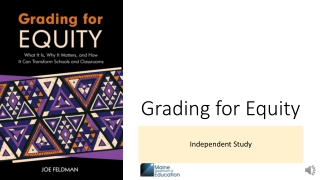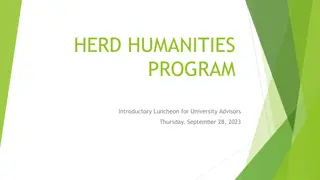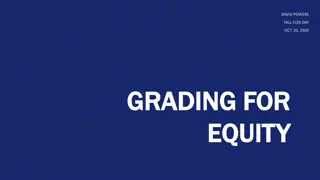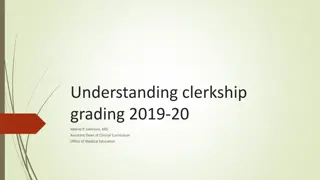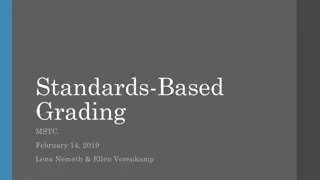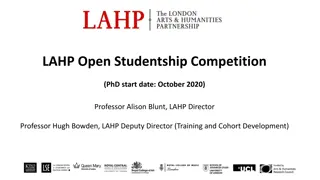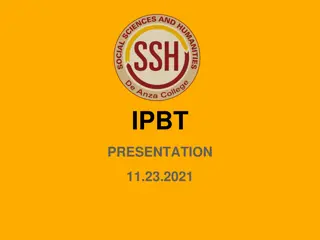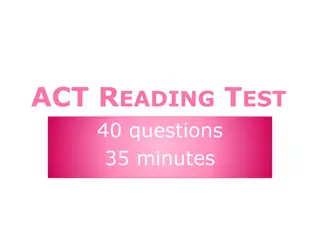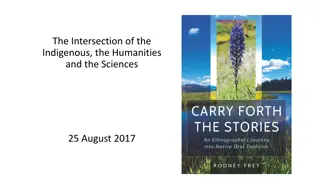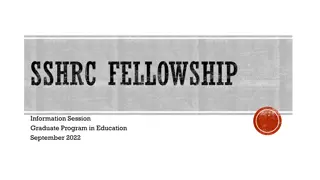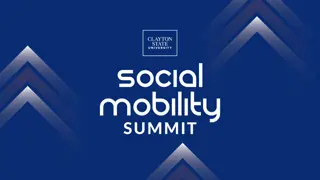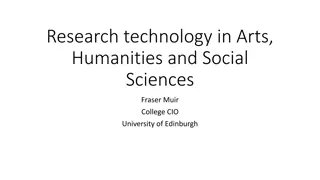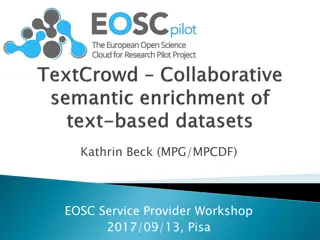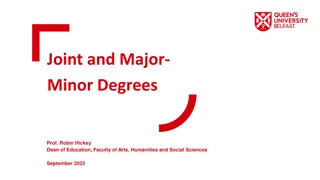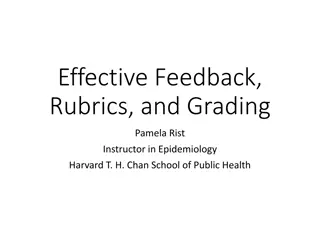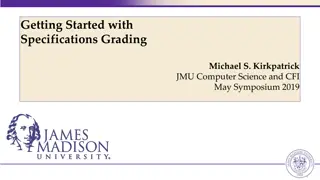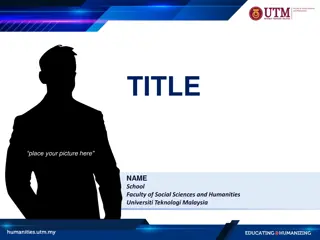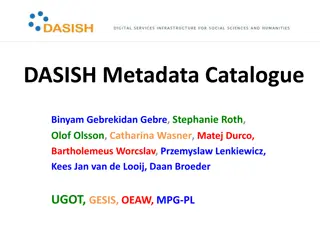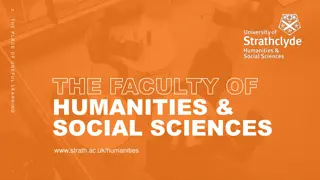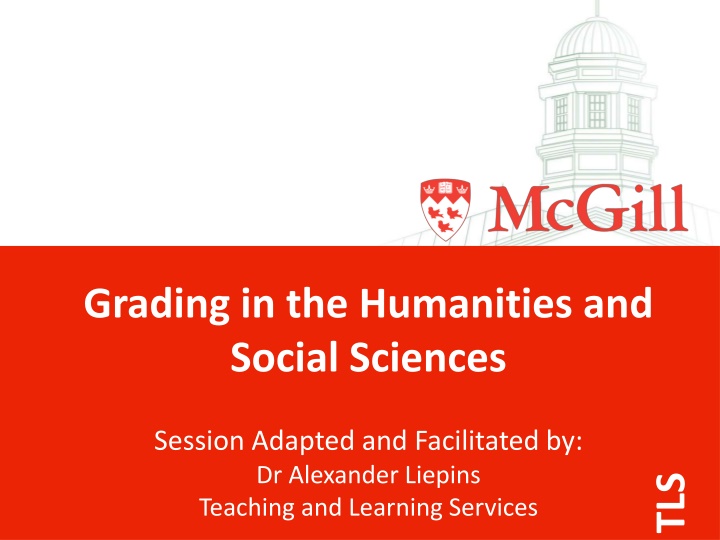
Grading in Humanities and Social Sciences: Workshop Insights
This session, led by Dr. Alexander Liepins, delves into assessment strategies, criteria development, and handling plagiarism in Humanities and Social Sciences. Explore the dual role of assessment, formative and summative strategies, and examples of assessments applicable to various fields.
Download Presentation

Please find below an Image/Link to download the presentation.
The content on the website is provided AS IS for your information and personal use only. It may not be sold, licensed, or shared on other websites without obtaining consent from the author. If you encounter any issues during the download, it is possible that the publisher has removed the file from their server.
You are allowed to download the files provided on this website for personal or commercial use, subject to the condition that they are used lawfully. All files are the property of their respective owners.
The content on the website is provided AS IS for your information and personal use only. It may not be sold, licensed, or shared on other websites without obtaining consent from the author.
E N D
Presentation Transcript
Grading in the Humanities and Social Sciences Session Adapted and Facilitated by: Dr Alexander Liepins Teaching and Learning Services TLS
Opening Activity What is your department? What is something you know about the topic? What are your challenges and concerns about grading?
Workshop Objectives Examine the dual role of assessment in courses Develop criteria and standards for grading Identify strategies to deal with plagiarism
THE DUAL ROLE OF ASSESSMENT IN COURSES
The Dual Role of Assessment Summative: What have students achieved in terms of learning outcomes (milestones, domain of knowledge, high-stakes). Formative: How are students learning (meta- cognition, critical thinking, self-evaluation, feedback, low-stakes).
Summative Strategies What are some examples of summative assessments that apply to your field? Hint: Think about the learning outcomes of one of your courses
Formative Strategies Clarify what good performance is Facilitate self-assessment Deliver high-quality feedback information Encourage teacher and peer dialogue Encourage positive motivation / self-esteem Provide opportunities to close the gap Use feedback to improve teaching Nicol, D. J., & Macfarlane Dick, D. (2006). Formative assessment and self regulated learning: A model and seven principles of good feedback practice. Studies in higher education, 31(2), 199-218.
Formative Strategies What are some examples of formative assessments that apply to your field? Hint: How would you help someone move toward the learning outcomes?
Examples of Assessments Formative Summative In-class discussions Instructor-created exams Clicker/polling questions Standardized tests Low-stakes group work Final projects Weekly quizzes Final essays / papers 1-min paper / reflection Final presentations Homework assignments Final reports Surveys Final grades Adapted from: Yale Center for Teaching and Learning. 2018. Formative and Summative Assessment. Retrieved from: https://ctl.yale.edu/Formative-Summative-Assessments
CRITERIA AND STANDARDS FOR GRADING
Establishing Criteria & Standards Criteria Minimum Requirements Standards Levels of Performance
Criteria & Standards What is a rubric? A tool for assessment Why are rubrics important? Rules for scoring Transparency Guide for students in bringing their work to a high(er) standard
Excellent Good Needs Improvement Author attempts to address main question or issue, but fails. The author has retained some information from the course, but does not fully understand its meaning or context and cannot clearly convey it to others. Poor Author directly addresses main question or issue, and adds new insight to the subject not provided in lectures, readings, or class discussions. The author has retained nearly all of the knowledge presented in class. They are able to synthesize this knowledge in new ways and relate to material not covered in the course. Essay contains a clear argument i.e., lets the reader know exactly what the author is trying to communicate. Author competently addresses main question or issue, but does not add much new insight into the subject. That said, it is clear that the author has learned a great deal in class and is able to communicate this knowledge to others. Essay does NOT address main question or issue, and it is obvious that author has not retained any information from the course. Overall Impression An argument is present, but reader must reconstruct it from the text. Author attempts, but fails, to make an argument (e.g., starts with a rhetorical question/statement or anecdote that is never put into context). No attempt is made to articulate an argument. Argument Provides compelling and accurate evidence that convinces reader to accept main argument. The importance/relevance of all pieces of evidence is clearly stated. There are no gaps in reasoning i.e., the reader does not need to assume anything or do additional research to accept main argument. Provides necessary evidence to convince reader of most aspects of the main argument but not all. The importance/ relevance of some evidence presented may not be totally clear. Reader must make a few mental leaps or do some additional research to fully accept all aspects of main argument. Not enough evidence is provided to support author s argument, or evidence is incomplete, incorrect, or oversimplified. Information from lectures and readings is not effectively used. Either no evidence is provided, or there are numerous factual mistakes, omissions or oversimplifications. There is little or no mention of information from lectures and readings. Evidence From: Aronson, J. 2016. Essay and Research Paper Grading Rubric. Carnegie Mellon University. Retrieved from: https://www.cmu.edu/teaching/assessment/assesslearning/rubrics.html
Developing a Rubric 1. Define the goal and purpose of the task that is being evaluated 2. Decide what kind of rubric to use 3. Define the criteria 4. Define the levels of performance 5. Write descriptions for each performance level of the rating scale 6. Test the rubric, revise, and put it into practice
How might the use of rubrics benefit students? Makes explicit the processes that the learner needs to use to understand the subject or discipline Fosters higher level thinking Allows students to become more deeply involved in the learning process Helps students evaluate their own work Helps students give each other constructive feedback
How might the use of rubrics benefit instructors? Defines expectations Provides feedback to instructor on students strengths & weaknesses Saves overall time Fosters consistency and fairness Increases consistency across multiple graders Helps colleagues reach agreement on common goals Supports instructor if/when students have questions about their grade(s)
Assessment of an Academic Paper Activity! Instructions: Form groups of 3 to 4 Each group will develop one criteria and the description of the various levels of performance for that same criteria
Rubric for Article Critique EXCELLENT GOOD NOT SATISFACTORY The abstract of the article written by the authors is rephrased. I: Summary The main themes and relevant information of the article are identified and presented in concise way. Some of the main themes and relevant information of the article are identified and presented in concise way. Demonstrates a complete understanding of the overall meaning of the article and its connection with some of the concepts of the course. Conclusion is logical but may not be completely related to the analysis. Incomplete recommendations are made on how to improve the study. II: Analysis Demonstrates a deeper understanding of the overall meaning of the article (s) and its connection with the concepts of the course. Demonstrates a lack of effort for understanding the overall meaning of the article and its connection with the concepts of the course. III: Conclusion A logical conclusion is drawn from the critical analysis, and precise recommendations made on how to improve the study. Conclusion is vague and unrelated to the critical analysis; Conclusions are too general to be useful. Recommendations to improve the study are unrelated to the critical analysis, and/or are too vague to be useful.
Grading Bias Develop your ability to assess the work as distinct from the student Develop your awareness of culture issues and avoid making cultural assumptions What are some potential biases?
Plagiarism According to the McGill Regulation on the Conduct of Research Plagiarism means the representation of another s work, published or unpublished, as one s own or assisting another in representing another s work, published or unpublished, as his or her own. https://www.mcgill.ca/research/files/research/conduct-of-research-regulation-on.pdf
Possible Indicators Changes / irregularities in writing style Incorrect citation Self-plagiarism Close collaboration
Stopping Plagiarism There is no assignment that cannot be plagiarized Education talk about plagiarism Formative assignments on proper citation or paraphrasing are a good strategy
Tips Review your rubric with your students Write comments on assignments, but pick your battles Give your students examples of good and bad assignments Mark with other TAs or with the instructor What are some other tips?
Resources Fair Play A Guide to Academic Integrity http://www.mcgill.ca/students/srr/honest/students Academic Integrity Office of the Dean of Students https://www.mcgill.ca/deanofstudents/students/student-rights-responsibilities/integrity Regulation on the conduct of research - McGill https://www.mcgill.ca/research/files/research/conduct-of-research-regulation-on.pdf Annual Report on Student Discipline - McGill https://www.mcgill.ca/students/srr/disciplinary/annual-report Website on dealing with plagiarism http://www.plagiarism.org/ Article on plagiarism checker limitations https://www.plagiarismtoday.com/2011/12/07/the-limitation-of-every-plagiarism-checker/
Thank you for participating! Acknowledgements: Dianne Bateman Carolyn Samuel Alexander DeGuise Holly Garnet Mitchell Brown Ariadna Camargo Balcazar

